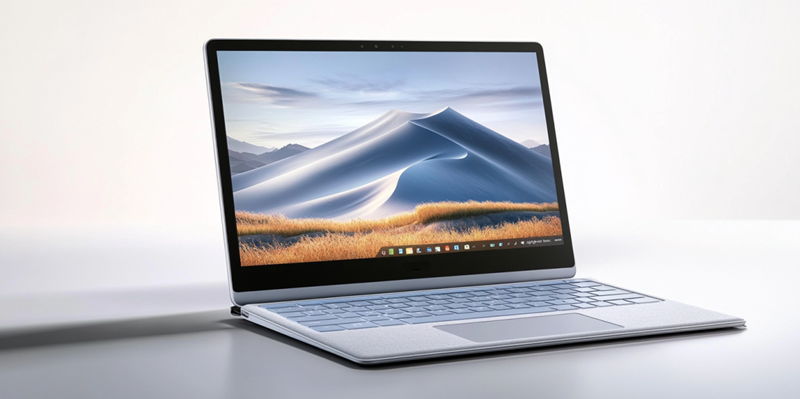Microsoft’s strategy to integrate both Arm and Intel processors in its hardware lineup is increasingly clear with the upcoming Surface Laptop 7. In the past, Microsoft’s efforts to incorporate Arm CPUs into its Windows ecosystem have faced numerous challenges, leading to mixed results and user dissatisfaction. However, recent developments in Windows 11 and advancements in Qualcomm’s Snapdragon chips have rekindled hope for seamless Arm integration. Despite this renewed optimism, a recent leak has shown that Microsoft isn’t completely shifting away from Intel’s x86 architecture. The Surface Laptop 7, expected to hit the shelves in 2025, will feature cutting-edge Intel Lunar Lake chips, a move that indicates x86 processors remain a cornerstone of Microsoft’s strategy.
In a development that caught the tech world’s attention, a Chinese retailer inadvertently listed a version of the Surface Laptop 7 equipped with an eight-core Intel Core Ultra 7 268V processor. This rather unexpected listing offered more than a glimpse into the future of Microsoft hardware. The Core Ultra 7 268V, boasting four high-power cores and four low-power cores without hyperthreading, is notable for its commendable speed, efficiency, and GPU performance, albeit slightly lagging behind some competitors in multithreading tasks such as video encoding and rendering. Accompanying the powerful CPU are 32GB of RAM and a storage capacity of up to 1TB. Priced at approximately $2,600, this model mirrors the high cost of its Snapdragon X Elite variant, underlining Microsoft’s commitment to providing premium options regardless of the under-the-hood architecture.
The Dual-Faceted Approach: Embracing Arm and x86
For some time, Intel has grappled with issues related to AI throughput and performance inconsistencies in its Raptor Lake CPUs. These struggles are among the catalysts pushing Microsoft to give Qualcomm’s Arm-based solutions another shot. Yet, Intel has not remained idle; its swift development and release of the Lunar Lake chips have garnered positive reviews and could mark a period of resurgence for the tech giant. The Surface Laptop 7’s impending release with these powerful new Intel processors suggests that Microsoft is carefully treading a path that balances innovation with reliability. By maintaining a dual-platform approach, incorporating both Arm and x86 processors, Microsoft aims to harness the strengths of each architecture to meet diverse consumer needs.
The broader industry trend towards flexibility and adaptability in hardware cannot be ignored. Many industry observers see this dual-faceted strategy as a hedge against the uncertainties of over-relying on one type of processor. While Arm processors have started to show increased compatibility and efficiency for specific applications, such as mobile and lightweight computing, x86 processors continue to dominate when it comes to robust performance for demanding tasks like gaming, content creation, and enterprise-level computing. This nuanced strategy could serve Microsoft well, enabling them to offer products that are both versatile and powerful without boxing themselves into a corner.
Technological Balancing Act: Adapting to Market Trends
The unfolding details about the upcoming Surface Laptop 7 highlight Microsoft’s commitment to technical adaptability in an ever-evolving market. A few years ago, the notion of relying heavily on Arm processors would have seemed impractical given the Windows ecosystem’s dependency on x86 architecture. Fast forward to today, and the scenario appears much more balanced, indicating Microsoft’s capability to pivot according to market demands and technological advancements. A blend of Qualcomm’s Snapdragon and Intel’s x86 chips in one product lineup reflects Microsoft’s understanding that no single architecture holds all the answers.
This balancing act is not just about internal business strategy; it responds to a broader market reality where different users have varying performance and efficiency requirements. While laptops powered by Arm processors excel in battery life and overall efficiency, their x86 counterparts are superior in raw performance. By offering devices that can cater to both ends of the spectrum, Microsoft is ensuring that their hardware meets a wide range of user needs without making significant compromises. In the grand scheme, this technology-agnostic approach strengthens their appeal to both individual consumers and enterprise customers.
Conclusion
Microsoft’s strategy to include both Arm and Intel processors in its hardware is evident with the upcoming Surface Laptop 7. Historically, Microsoft’s efforts to integrate Arm CPUs into its Windows ecosystem have faced numerous hurdles, leading to mixed user reactions. However, advancements in Windows 11 and Qualcomm’s Snapdragon chips have revived hope for successful Arm integration. Yet, a recent leak indicates Microsoft isn’t abandoning Intel’s x86 architecture. The Surface Laptop 7, expected in 2025, will feature Intel’s next-gen Lunar Lake chips, showing that x86 remains crucial to Microsoft’s plans.
A surprising development came when a Chinese retailer accidentally listed a Surface Laptop 7 version with an eight-core Intel Core Ultra 7 268V processor. This unintentional leak highlighted Microsoft’s future hardware direction. The Core Ultra 7 268V, with four high-power and four low-power cores sans hyperthreading, is noted for its impressive speed, efficiency, and GPU performance, though it slightly lags in tasks like video encoding. Featuring 32GB of RAM and up to 1TB of storage, this model, priced around $2,600, mirrors the cost of its Snapdragon X Elite counterpart, underscoring Microsoft’s commitment to premium options regardless of the underlying technology.

